30 Fine-Art Photos of Chernobyl Never Seen Before
When we think of Chernobyl, three words come to mind: radiation, cancer, mutation. We forget this was once a beautiful city loved by it's inhabitants. In tribute to them, this is a collection of 30 fine-art photographs taken in 2011 and never seen before: apartments, schools, offices, shops, it's all here, and each image has an explanation by a former resident. http://smithjan.com/blog/2011/04/27/pripyat-atoms-wake/
-
View of Pripyat - The City Chernobyl Vanquished

The Polissya café hosted official banquets and offered views of the sickle shaped city center. In darker times, the same floor allegedly functioned as the control center for helicopters dumping sand on Reactor #4.
-
Pripyat City Center

From the drawing board, Pripyat was designed as a vibrant hub for the region’s existing inhabitants. The city’s center was impressive. Visitors arrived downtown, at the Palats Kultury (Culture Palace). It served as city hall, convention center, and luxurious sports facility all rolled into one. The complex was flanked to the west by a large restaurant and a supermarket—which for the times was both a luxury and a novelty. To the east the Polissya Hotel provided comfortable accomodations.
-
Pripyat Government Buildings
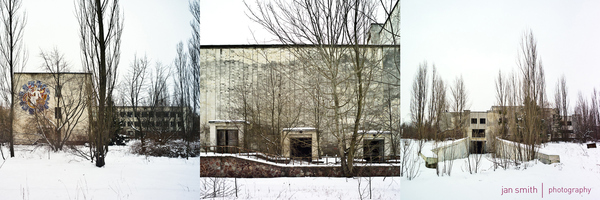
Even compared to Western cities of its size, Pripyat held its own in terms of infrastructure and amenities. The KBO, or city commissary boasted barbers, hairdressers, tailors, cobblers, a small day-care, and a place to get photocopies. Both a second commissary, and supermarket were in the works prior to the accident. An outlet of the famed Moscow toy store--Detsky Mir (Children’s World) was planned, along with a repeater TV station broadcasting three channels.
-
Pripyat Cinema

Kinoteatre Prometeu, was Pripyat’s first movie theatre and sat upwards of 500 people. It had a namesake statue of Prometheus, receiving the gift of fire at its entrance. During the clean-up efforts, the radioactive ground around the cinema’s entrance was torn up, taken away, and buried. The hallmark statue was salvaged either by luck or design, and is now part of a memorial outside of Reactor #4.
-
Pripyat Theatre and Music School

The west wing of Pripyat’s movie theatre was decorated with mosaics, and served as a dance school and music auditorium. It was named after the Greek god of fire. “You know the Greek legend of Prometheus? Da? Well that was an ironic way to foretell that our livers would be picked. Maybe for once [Soviet propaganda was] telling the truth,” laughs Max, a former resident.
-
Chernobyl Harbor and Railroad

Although built to accommodate the workers at the Chernobyl nuclear power plant, Pripyat also served as a hub for transportation and light manufacturing activities. The nearby Yaniv railway station, that played a strategic role in WWII, was used for both passenger and cargo, and a river port was being expanded prior to the accident.
-
Pripyat Farms
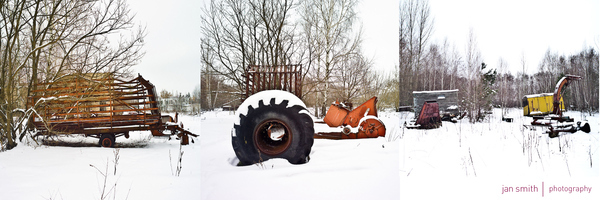
Pripyat had considerable agricultural activities. Chernobyl, fifteen minutes down the road, and 800 years old, was a farming town that bestowed a germane influence on Pripyat. “My uncle lived on a farm near Pripyat. He would bring us slabs of bacon [to Kiev] in the winter, with the real spicy mustard, not the sweet crap you get today. You know, the type that you only need a couple of drops to taste. Real Gorcheetsa,” recalls Petro, who for the last nine years works as a driver for tours to Chernobyl and Pripyat.
-
Pripyat Fish Factory
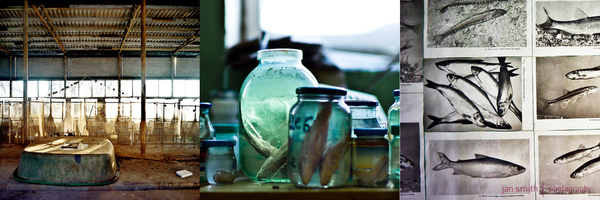
Outside the city, near the cooling towers, a small fish processing plant provided modest amounts fresh catch. After the accident in 1986, it was used as a laboratory to study the effects of radiation on fish. As evidenced by the newspapers left behind, and the expiration dates on some old medicines, it served in this capacity until roughly 1996, when it was finally abandoned.
-
Pripyat Mechanic Workshop
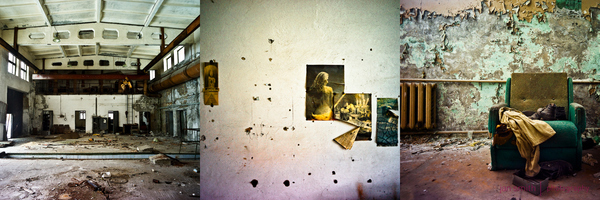
A walk of among the western limits of the city reveals small grain storing facilities, green houses, and mechanic shops for tractors. Inside the shops, as with mechanics around the world, newspaper cut-outs of women still hang on the walls. Images of feasts and candles flank the shoulders of one woman, while another lady kneels down across a landscape of cracked mud. Combined, the cut-outs evoke more a sense of pastoral sensuality than sex.
-
Pripyat Cafe

Young couples spent afternoons on the pier by the Pripyat Café, with its stained glass windows. The average age in Pripyat was 26.
-
Pripyat Pier

The pier by the Pripyat Café was a favorite place to relax and watch sail boats during the warmer months. In the winter children and families could be seen ice-skating. Andrei, who was sixteen at the time of the accident, has childhood memories by the Pripyat river. “We would play or go fishing by the river while my parents and their friends organized barbecues in the woods nearby… In the winter I remember seeing older men ice fishing.”
-
Pripyat Sports Facilities
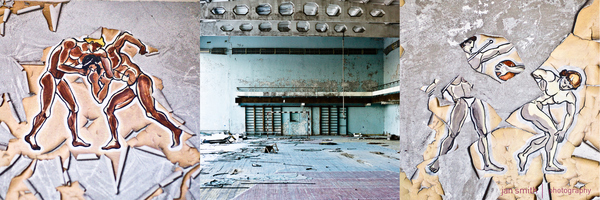
With the 1980 Olympics as a backdrop, many of the public facilities made sports a key element in social activities. “It was a big honor for us to participate,” explains former resident Karina. “Swimming. Races. Relays. Always something, somewhere, in some school or complex. Always,” she adds.
-
Pripyat Sports Facilities

Pripyat’s sports teams trained hard in the Culture Palace and were well known for being strong. Vlad, who always lived in Kiev, and is now a DJ, remembers playing football against boys from Pripyat, the summer immediately after the accident. “A group of kids was sent to our Pioneer camp and we teased them, calling them radioactive. But they got back at us by humiliating us on the field.”
-
Pripyat Stadium
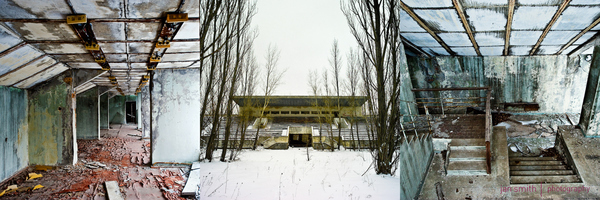
Outdoor sports in Pripyat were common. A stadium was built in 1980, and while the weather permitted, it hosted track events and football matches. The local varsity football team was considered strong and residents in nearby buildings recall kicking-back and watching games from their balconies.
-
Pripyat Pools

The largest of five pools had a ten-meter diving platform, and next to it a lap-pool was reserved for Party Officials. According to persons who continued working at the Chernobyl power plant after the accident, this particular pool was kept operational until the year 2000 as a recreational facility. Prior to that, literally thousands of children learned to swim there.
-
Pripyat Hospital and Clinics

Pripyat boasted impressive medical infrastructure. A full service clinic, known as MSD-126 (Medical Sanitation Department), hosted the medical workers’ union, and housed a swimming pool with a special overhanging carriage for physiotherapy. Over 700 babies were born in the city hospital each year. Today, the hospital is a wounding reminder of what went wrong the night of April 26th.
-
Pripyat Hospital and Clinics

“Prophylactics for Radiation Injuries,” reads a rotting billboard in a corridor on the second storey of Pripyat hospital. Downstairs, in the emergency room, radiation readings are some of the highest in the city. On the night of the meltdown, the firemen who extinguished the reactor’s fire contaminated the ward with their bodies. While putting out the fire, they absorbed radiation and became threats to the doctors and nurses treating them.
-
Soviet Billboards in Pripyat

Many more billboards hang in foyers throughout the city, in the same place they were twenty-five years ago. Some are a confusing orgy of Communist Party acronyms. Others are long-winded patriotic hyperbole, honoring the exploits the people’s army over Nazi Germany. The overall effect of the many surviving stars and propaganda, makes Pripyat feel like a crumbling museum of all things Soviet.
-
Soviet Education in Pripyat
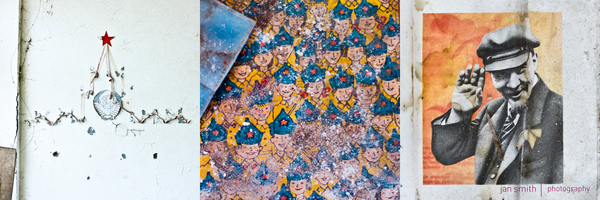
Children were gradually brought into the Communist Party’s fold in school and by participating in mandatory scout organizations. Sasha, who was six at the time, remembers wearing a read star on her cap or lapel. It indicated she was a Little Octoberist, and part of the first of three scout orders. “I so badly wanted to become a Pioneer and wear a read handkerchief around my neck like the older girls,” she recalls.
-
Pripyat Classrooms

Lenin’s role in education debuts in first grade with a soft and fatherly smile, reading to children on his lap. A few grades further up, he is regularly stern faced, and leads in poems and plays about the Motherland. By the equivalent of middle school his visage is fierce and determined. His speeches decorate the walls alongside maps of the USSR and the Oath to the Red Army.
-
Pripyat Electric Room Nuclear Energy Company
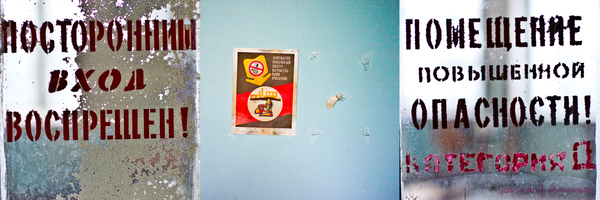
As a nuclear plant, safety and caution were heralded by the Communist Party as underpinning values in Pripyat’s work force. The Party controled access to rooms, and even advised on the use of electric tea boilers. In practice, however, caution was lax. Many transfers to the power plants were based on politics rather than merit. This diluted the technical capacity of plant personnel--a key factor the IAEA, in its post-mortem analysis, cited as a contributing cause to the accident.
-
Inside Pripyat Bank Offices

In the aftermath of the accident Pripyat’s key utility services were maintained operational by military staff for use during the clean-up efforts. Skeleton staff on rotating shifts maintained electricity, water, and telecommunications. Public offices such as the bank, were emptied of furniture and fixtures less than private residences.
-
Inside Pripyat's Empty Apartments
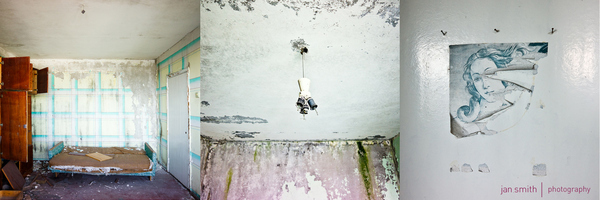
Families were evacuated with only one bag per person. Clean-up crews, known as liquidators, disposed of what was left behind. Furniture, domestic appliances, clothing, dead pets, piping, plumbing and electric fixtures were tossed out windows into the streets below. They were then loaded on to trucks and taken away for burial.
-
Radioactive Crushed Cars of Pripyat

Most valuable articles, such as cars and electrical appliances were deliberately crushed prior to burial, but former residents believe many of their belongings were instead stolen. Whether fact or fiction, an urban myth rapidly propagated in the months after the evacuation: radioactive TVs were being sold in Kiev, until those responsible for doing so were caught and executed. Dimitri, a former liquidator disagrees, “Even if we considered it, we were too busy and too scared to do it.”
-
Pianos and Empty Rooms in Pripyat

Apart from pianos and Soviet books and newspapers, it is rare to find personal belongings in Pripyat’s apartments. When asked about the many pianos left behind, Dimitri, who served as a liquidator, responds dryly, “They were too heavy to move.”
-
Nature Returning to Pripyat
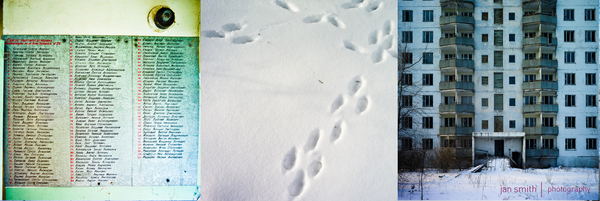
Today, all that is left of Pripyat are empty apartment buildings with the name of former residents in the foyers. Nature is reclaiming the space. Deer roam the former city parks, and wolves and boar make dens in the basements of buildings.
-
Ferris Wheel in Pripyat
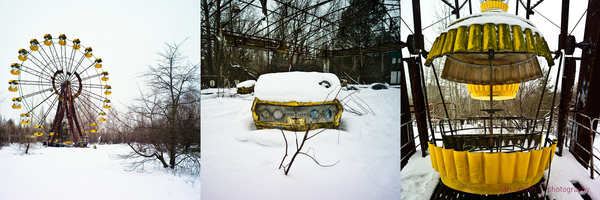
On May 1st, Pripyat was to open a small amusement park with large yellow Ferris wheel. The city was abandoned three days before it inaugurated. Symbolic of the city’s truncated potential, it is Pripyat’s best-recognized feature. Alexander, recalls the excitement he had when his mother took him to watchit being worked on. “I see pictures of it and think of an atom. You know, round and with little electrons in orbit…like an Odysseus horse it was put in the middle of the city: a big round, happy yellow atom, that rolled over us one night.”
-
Pripyat an Empty City
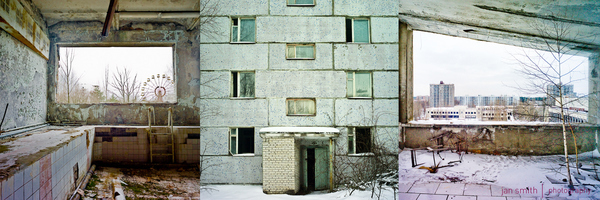
It is hard to remember a place that existed for less than two decades, and even in Ukrain Pripyat’s name is often lost within the magnitude of the Chernobyl accident. “It doesn’t matter if people don’t know the name and can’t distinguish it from Chernobyl,” remarks Ms. Anna Vitalievna, Deputy Director of the Chernobyl Museum, “What matters is that they understand what happened and how to avoid it.”
Become a Community Contributor.

